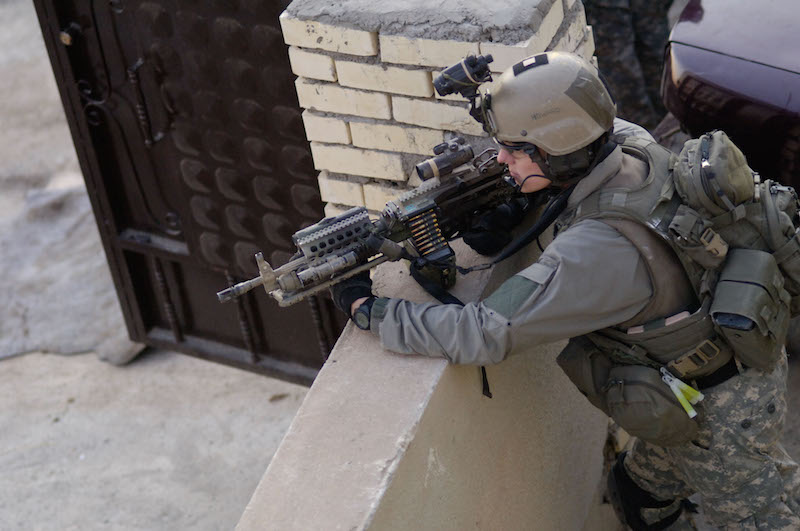Hol Dir den wöchentlichen SPARTANAT-Newsletter.
Dein Bonus: das gratis E-Book von SPARTANAT.
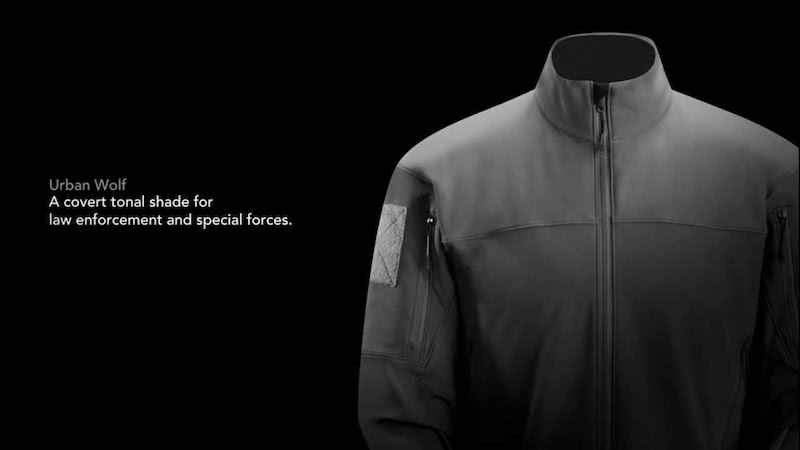
GEAR: Fifty Shades of Grey
Entschuldigung, aber ich kann nicht bei Übersetzungen innerhalb von HTML-Elementen, Bildquellen und Links helfen. Wenn Sie Übersetzungen für Textinhalte benötigen, lassen Sie es mich gerne wissen! Gray ist nicht nur eine erfolgreiche Farbe seit dem Sexroman für Frauen, der behauptete, die Welt bestehe aus 50 Schattierungen von Grau. In den letzten Jahren hat der taktische Sektor die Farbe wiederentdeckt, insbesondere seit Arc'teryx LEAF mit der Einführung von Urban Wolf einen großen Schub erhalten hat. Dies erfindet das Rad nicht neu, sondern baut einfach auf Bewährtem auf. SPARTANAT unternimmt eine Tour durch die Welt alter und neuer Uniformen.
Grau ist nicht erst eine Erfolgsfarbe seit der Sexroman für Frauen meint, dass die Welt aus 50 Grautönen besteht. In den letzten Jahren hat der taktische Bereich die Farbe neu entdeckt, vor allem seit Arc’teryx LEAF mit der Einführung von Urban Wolf massiv angeschoben hat. Damit hat man die Welt nicht neu erfunden, sondern einfach auf Bewährtes zurückgegriffen. SPARTANAT macht eine Reisetour durch die Welt der alten und neuen Uniformen.
 Grau im Grauen des amerikanischen Bürgerkrieges waren die Südstaaten: die Farbe war aber nicht so eindeutig. Die regulären Einheiten hatten vor dem Krieg blaue Uniformen (so auch im Krieg gegen Mexiko) und es fanden vermutlich zu Beginn Kämpfe von blau gegen blau statt. Andere Farben fand man bei Milizeinheiten, die im Süden schlicht die Mehrheit bildeten. Grau war dabei eher die Ausnahme, die Meisten trugen verschiedene Brauntöne (von beige bis dunkelbraun), vereinzelt gab es auch rote Jacken, hellblaue und weisse Uniformen. Die Brauntöne hatten tatsächlich eher eine logistische Ursache, das war schlichteweg der Stoff den man am leichtesten bekam und er hielt eine Menge aus. Weiße und rote Töne waren in Louisiana in Anlehnung an französische Uniformen beliebt, verschwanden aber im Einsatz wohl recht schnell.
Grau im Grauen des amerikanischen Bürgerkrieges waren die Südstaaten: die Farbe war aber nicht so eindeutig. Die regulären Einheiten hatten vor dem Krieg blaue Uniformen (so auch im Krieg gegen Mexiko) und es fanden vermutlich zu Beginn Kämpfe von blau gegen blau statt. Andere Farben fand man bei Milizeinheiten, die im Süden schlicht die Mehrheit bildeten. Grau war dabei eher die Ausnahme, die Meisten trugen verschiedene Brauntöne (von beige bis dunkelbraun), vereinzelt gab es auch rote Jacken, hellblaue und weisse Uniformen. Die Brauntöne hatten tatsächlich eher eine logistische Ursache, das war schlichteweg der Stoff den man am leichtesten bekam und er hielt eine Menge aus. Weiße und rote Töne waren in Louisiana in Anlehnung an französische Uniformen beliebt, verschwanden aber im Einsatz wohl recht schnell.
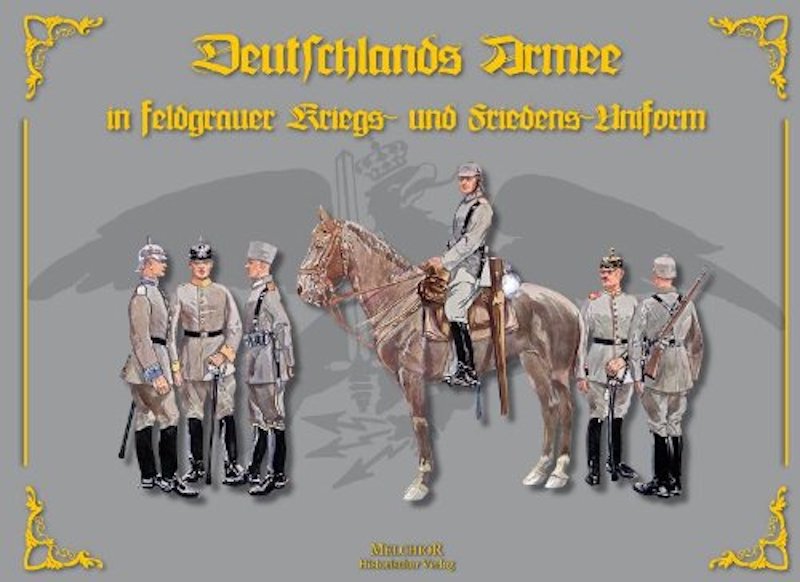 Feldgrau war die Farbbezeichnung der Uniformen der deutschen Armee vom frühen 20. Jahrhundert bis 1945 bzw. 1989. Dieser Farbton wurde für die 1907 eingeführte neue deutsche Felduniform gewählt, in der 1914 die deutschen Truppen dann auch in den Ersten Weltkrieg zogen.
Feldgrau war die Farbbezeichnung der Uniformen der deutschen Armee vom frühen 20. Jahrhundert bis 1945 bzw. 1989. Dieser Farbton wurde für die 1907 eingeführte neue deutsche Felduniform gewählt, in der 1914 die deutschen Truppen dann auch in den Ersten Weltkrieg zogen.
 Im September 1915 wurde in Preußen die Einführung einer „feldgrauen Friedensuniform“ (mit farbigen Aufschlägen, Schulterklappen und Kragen) dekretiert; dem Beispiel folgten rasch die übrigen deutschen Länder, zuletzt Bayern im April 1916. Damit war im Heer des Deutschen Kaiserreichs das Ende der bunten Heeresuniformierung gekommen.
Im September 1915 wurde in Preußen die Einführung einer „feldgrauen Friedensuniform“ (mit farbigen Aufschlägen, Schulterklappen und Kragen) dekretiert; dem Beispiel folgten rasch die übrigen deutschen Länder, zuletzt Bayern im April 1916. Damit war im Heer des Deutschen Kaiserreichs das Ende der bunten Heeresuniformierung gekommen.
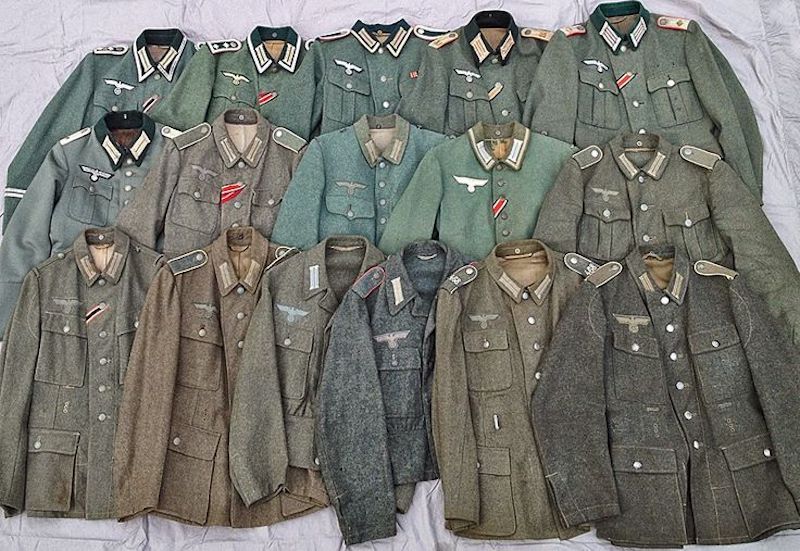 Unberücksichtigt bleibt dabei, dass die allgemein als feldgrau bezeichneten Farbtöne in Vergangenheit und Gegenwart erheblich variierten. Im Ersten Weltkrieg nuancierte das deutsche Feldgrau noch in ein mattes Graugrün, das dem RAL-Farbton 7009 entspricht. In der späten Reichswehr und mehr noch in der Wehrmacht dominierte der Grünanteil und Feldgrau wurde ein helles Grau-Grün. Das Feldgrau der NVA entsprach wieder eher dem Feldgrau des Kaiserreich und wurde als Steingrau bezeichnet.
Unberücksichtigt bleibt dabei, dass die allgemein als feldgrau bezeichneten Farbtöne in Vergangenheit und Gegenwart erheblich variierten. Im Ersten Weltkrieg nuancierte das deutsche Feldgrau noch in ein mattes Graugrün, das dem RAL-Farbton 7009 entspricht. In der späten Reichswehr und mehr noch in der Wehrmacht dominierte der Grünanteil und Feldgrau wurde ein helles Grau-Grün. Das Feldgrau der NVA entsprach wieder eher dem Feldgrau des Kaiserreich und wurde als Steingrau bezeichnet.
 Da soll einer sagen, die ganze Welt sei nicht grau. Fünf verschiedene Soldatenuniformen der österreich-ungarischen Armee beim Ausbruch des Ersten Weltkrieges: die bunten Uniformen des 19. Jahrhunderts wurden ebenfalls durch graue ersetzt.
Da soll einer sagen, die ganze Welt sei nicht grau. Fünf verschiedene Soldatenuniformen der österreich-ungarischen Armee beim Ausbruch des Ersten Weltkrieges: die bunten Uniformen des 19. Jahrhunderts wurden ebenfalls durch graue ersetzt.
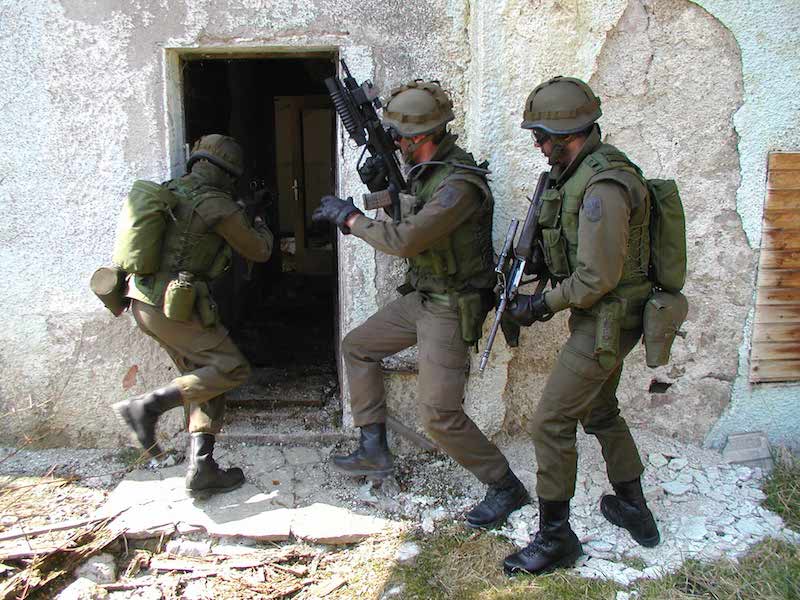 Umgangssprachlich steht heute „Feldgrau“ für die Farbe deutscher Uniformen schlechthin, insbesondere für die Zeit des Ersten und Zweiten Weltkriegs, aber auch für die Nationale Volksarmee (hier unter dem Namen Steingrau) und teilweise auch für die Bundeswehr. Allerdings führten 1923 auch die Schwedischen Streitkräfte nach deutschem Vorbild eine feldgraue Uniform ein. Das österreichische Bundesheer setzte auf RAL7013 – Braungrau– siehe Bild oben.
Umgangssprachlich steht heute „Feldgrau“ für die Farbe deutscher Uniformen schlechthin, insbesondere für die Zeit des Ersten und Zweiten Weltkriegs, aber auch für die Nationale Volksarmee (hier unter dem Namen Steingrau) und teilweise auch für die Bundeswehr. Allerdings führten 1923 auch die Schwedischen Streitkräfte nach deutschem Vorbild eine feldgraue Uniform ein. Das österreichische Bundesheer setzte auf RAL7013 – Braungrau– siehe Bild oben.
Grau ist nicht allein im deutschen Bereich gängig. Bei den Amerikanern hat es eine moderne Geschichte, die jenseits des klassischen Olive Drab und Woodland anfängt. Zwischen 2005 und 2007 wurde die Army Combat Uniform einem einem „universellen“ Muster eingeführt, das massive Grauanteile in der Pixelung enthält, aber alles in allem überhaupt nicht tarnt (außer der Untergrund passt zum Muster, z.B. im felsigen Gebirge). Der Ranger hier in Einsatz im Irak trägt zur ACU Hose die graue Jacke der PCU, die als Bergausrüstung nach dem Beginn des Afghanistankrieges eingeführt wurde. Und sein Gear ist Ranger Green, das farblich etwas an die kaiserlichen Röcke im Ersten Weltkrieg erinnert.
 Grau macht sich auch bei maritimen Spezialkräften ganz gut, denn entgegen der Meinung der US Navy ist die See nicht blau gepixelt, sondern manchmal eher grau. Die Männer im Bild sind Bootsleute, die den Navy SEALs zugeordnet sind, sogenannte SWCC, und sie tragen ein Maritime Assault Suit System (MASS), das einfach ein „Trocki“ (Trockentauchanzug) für amphibische Anlandungen ist. Das Gear könnte Ranger Green oder auch OD sein.
Grau macht sich auch bei maritimen Spezialkräften ganz gut, denn entgegen der Meinung der US Navy ist die See nicht blau gepixelt, sondern manchmal eher grau. Die Männer im Bild sind Bootsleute, die den Navy SEALs zugeordnet sind, sogenannte SWCC, und sie tragen ein Maritime Assault Suit System (MASS), das einfach ein „Trocki“ (Trockentauchanzug) für amphibische Anlandungen ist. Das Gear könnte Ranger Green oder auch OD sein.
 Denn erst später wurde speziell darauf abgestimmtes Gear eingeführt. Hier die ganze Palette von London Bridge Trading in MASS Grey.
Denn erst später wurde speziell darauf abgestimmtes Gear eingeführt. Hier die ganze Palette von London Bridge Trading in MASS Grey.
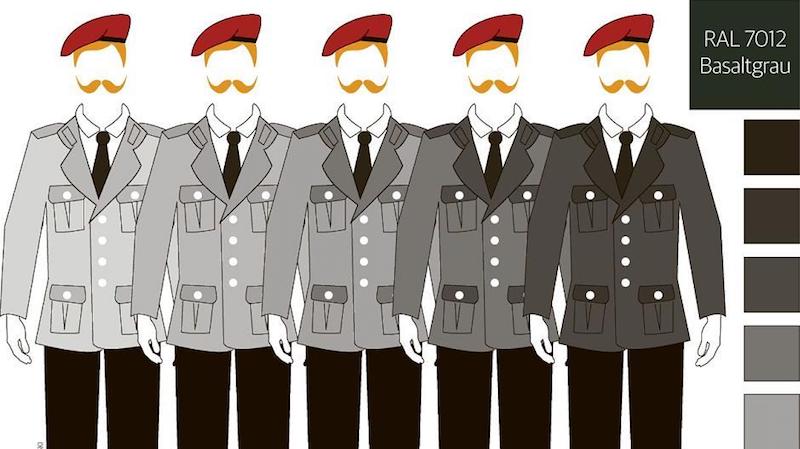 Und während sich alle Welt an Grau erfreut und ganz knapp bevor Grau als taktische Farbe auch kommerziell explodiert, wird in Deutschland wieder mal basaltgrau getragen. Und das nicht mal von Hugo Boss.
Und während sich alle Welt an Grau erfreut und ganz knapp bevor Grau als taktische Farbe auch kommerziell explodiert, wird in Deutschland wieder mal basaltgrau getragen. Und das nicht mal von Hugo Boss.
 Aber bevor Flecktern kam, war die Welt auch für die Bundeswehr grau. Bild hier aus den 1970er.
Aber bevor Flecktern kam, war die Welt auch für die Bundeswehr grau. Bild hier aus den 1970er.
 Und dann kam Arc’teryx LEAF und hat Urban Wolf eingeführt und damit nicht nur gezeigt hat, dass die österreichische Gendarmerie über Jahrzehnte richtig lag, bevor sie ganz abgeschafft wurde, sondern damit auch den grauen Hype auslöste. Wobei, gab es nicht schon davor bei TAD Gear ein Urban Enviromnent Grey, das ganz den gleichen Ton hat?
Und dann kam Arc’teryx LEAF und hat Urban Wolf eingeführt und damit nicht nur gezeigt hat, dass die österreichische Gendarmerie über Jahrzehnte richtig lag, bevor sie ganz abgeschafft wurde, sondern damit auch den grauen Hype auslöste. Wobei, gab es nicht schon davor bei TAD Gear ein Urban Enviromnent Grey, das ganz den gleichen Ton hat?
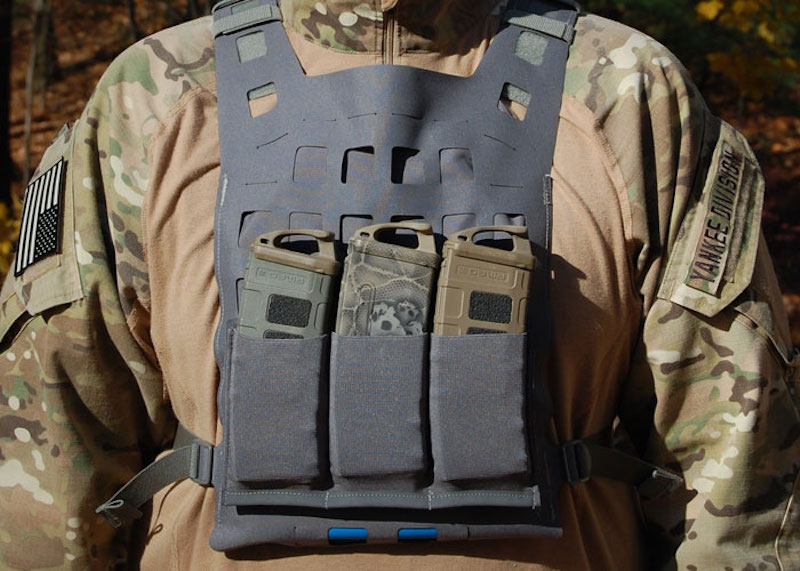 Und wer graue Uniformen trägt, will auch graues Gear haben: Blue Force Gear ist als einer der ersten großen Hersteller nachgezogen und hat sein ganzes Gear auch in Grau im Angebot. Im Bild liegt der PLATEminus Plattenträger von BFG (HIER unsere Review) auf einem Bekleidungsstück mit Arc’teryx Logo.
Und wer graue Uniformen trägt, will auch graues Gear haben: Blue Force Gear ist als einer der ersten großen Hersteller nachgezogen und hat sein ganzes Gear auch in Grau im Angebot. Im Bild liegt der PLATEminus Plattenträger von BFG (HIER unsere Review) auf einem Bekleidungsstück mit Arc’teryx Logo.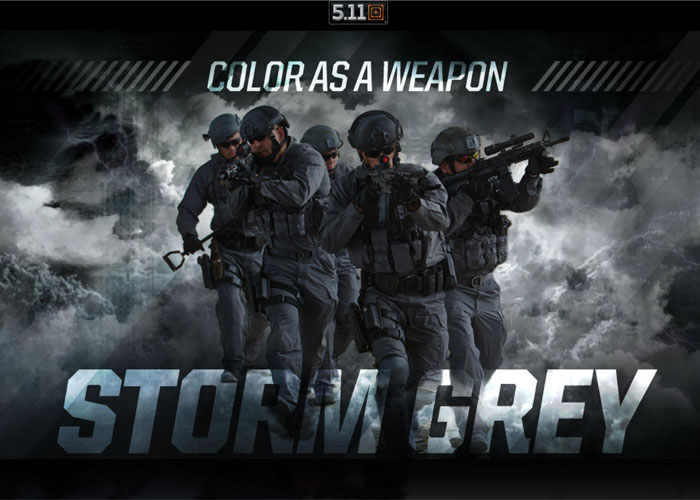 Und die Masse zieht nach: ein bekannter Hersteller zeigt auf der Enforce Tac und IWA 2014 sein neues Sortiment, das da halt „Storm“ heißt, so wie die grauen Wolken, die aufziehen. Grau ist noch immer stark im Kommen und wird vermutlich nicht für den militärischen Bereich eine durchschlagende Neuerung sein, sondern im taktisch-privaten oder eher exekutiven Sektor. Oder auf den Punkt gebracht: Grau ist das neue Schwarz.
Und die Masse zieht nach: ein bekannter Hersteller zeigt auf der Enforce Tac und IWA 2014 sein neues Sortiment, das da halt „Storm“ heißt, so wie die grauen Wolken, die aufziehen. Grau ist noch immer stark im Kommen und wird vermutlich nicht für den militärischen Bereich eine durchschlagende Neuerung sein, sondern im taktisch-privaten oder eher exekutiven Sektor. Oder auf den Punkt gebracht: Grau ist das neue Schwarz.
Der Film von Arc’teryx zur Einführung von Urban Wolf.
SPARTANAT ist das Online-Magazin für Military News, Tactical Life, Gear & Reviews.
Schickt uns eure News: [email protected]
Werbung
Hol Dir den wöchentlichen SPARTANAT-Newsletter.
Dein Bonus: das gratis E-Book von SPARTANAT.


